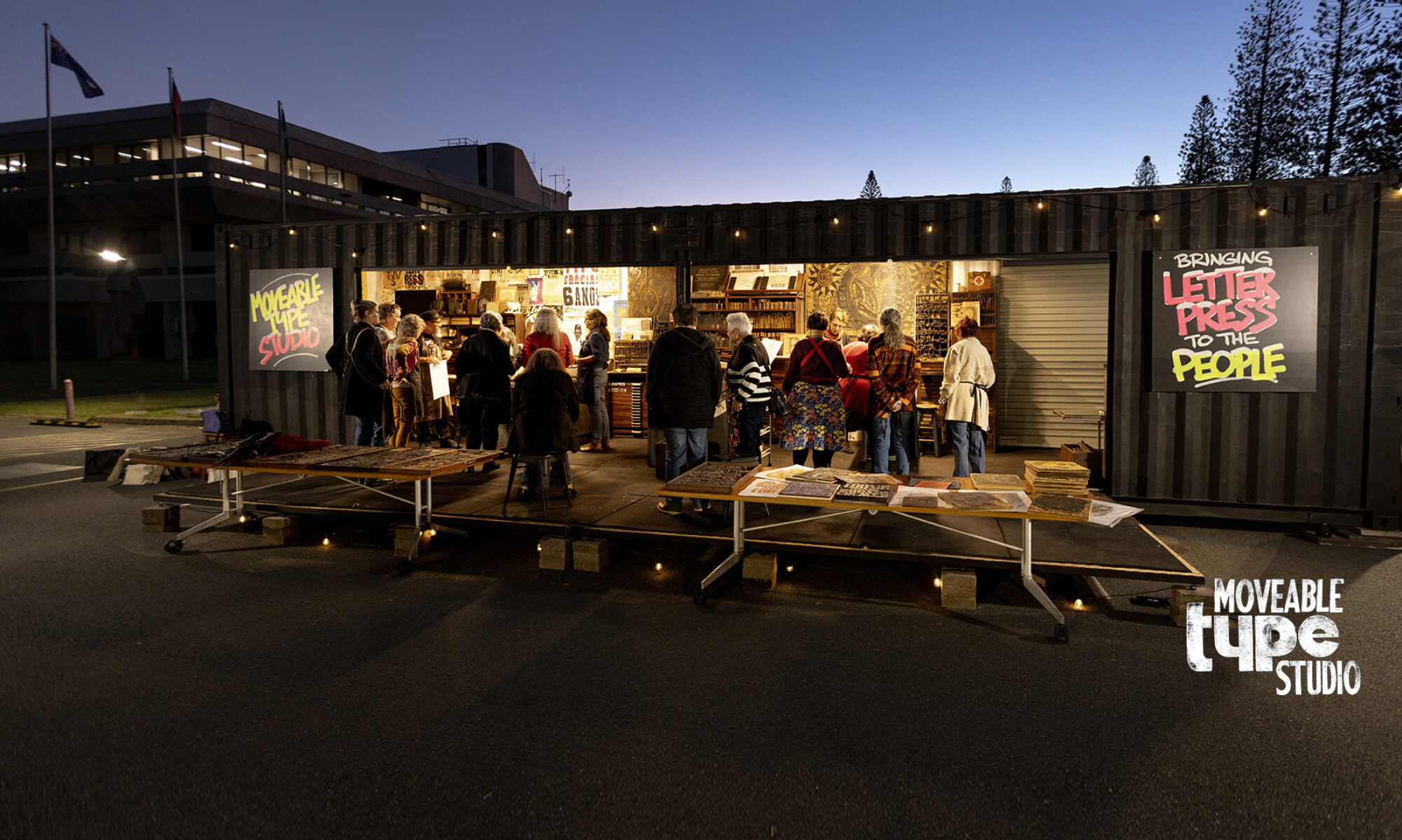Our inaugural letterpress workshop at The Paint Factory in Yeronga was a resounding success, set against a backdrop that couldn’t have been more perfect. Just 15 minutes from Brisbane’s CBD, The Paint Factory provides an incredible environment for creatives, fostering collaboration and innovation within a vibrant community.
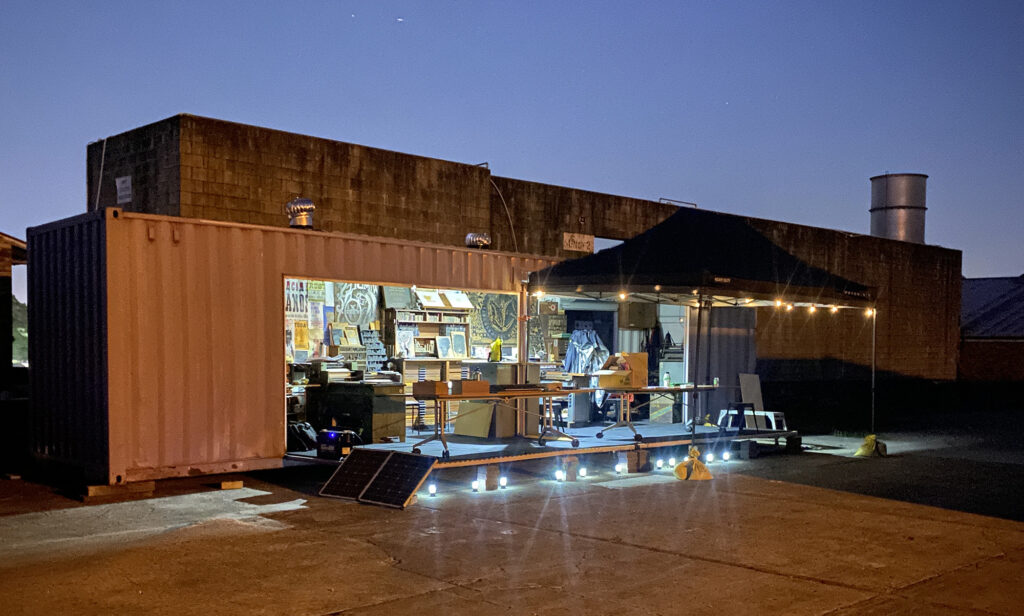
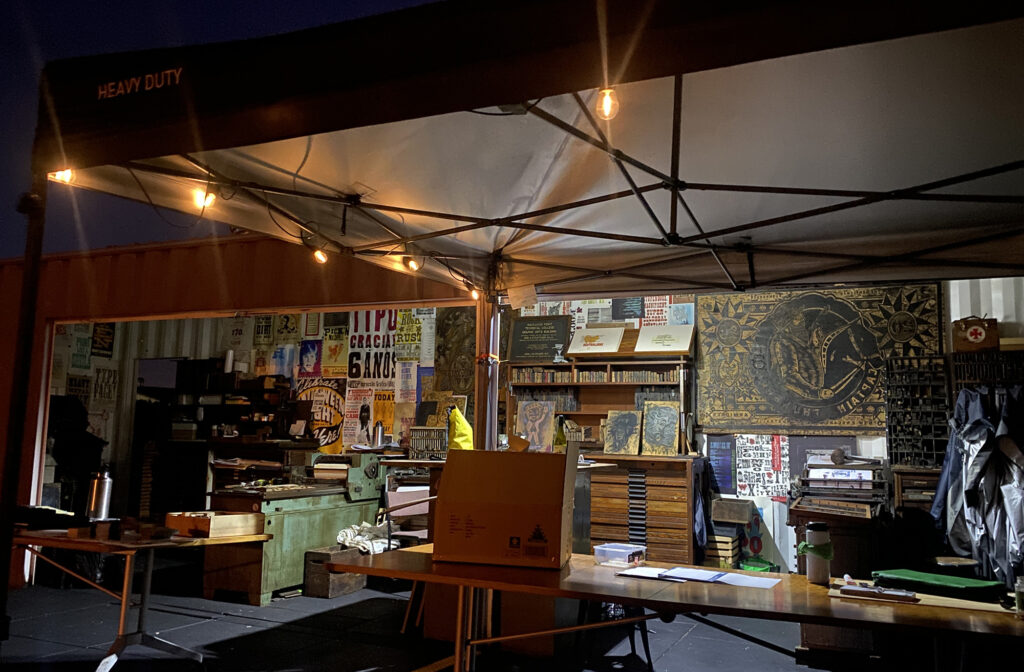
This workshop, held on a Sunday, was a true collaboration with the Brisbane Visual Arts Community (BVAC). BVAC is a dynamic collective of artists and art enthusiasts dedicated to nurturing creativity and artistic expression in Brisbane. With guilds specialising in various art forms—from painting and sculpture to textiles and ceramics—BVAC presents a rich tapestry of artistic talent. Our partnership with them offered their members a unique opportunity to delve into the traditional craft of letterpress printing, underscoring our shared commitment to enriching the local arts scene and providing valuable learning experiences.
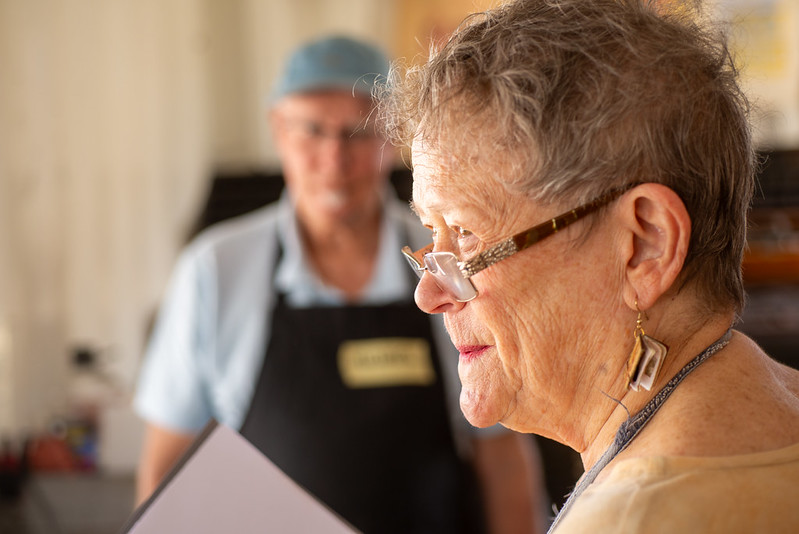
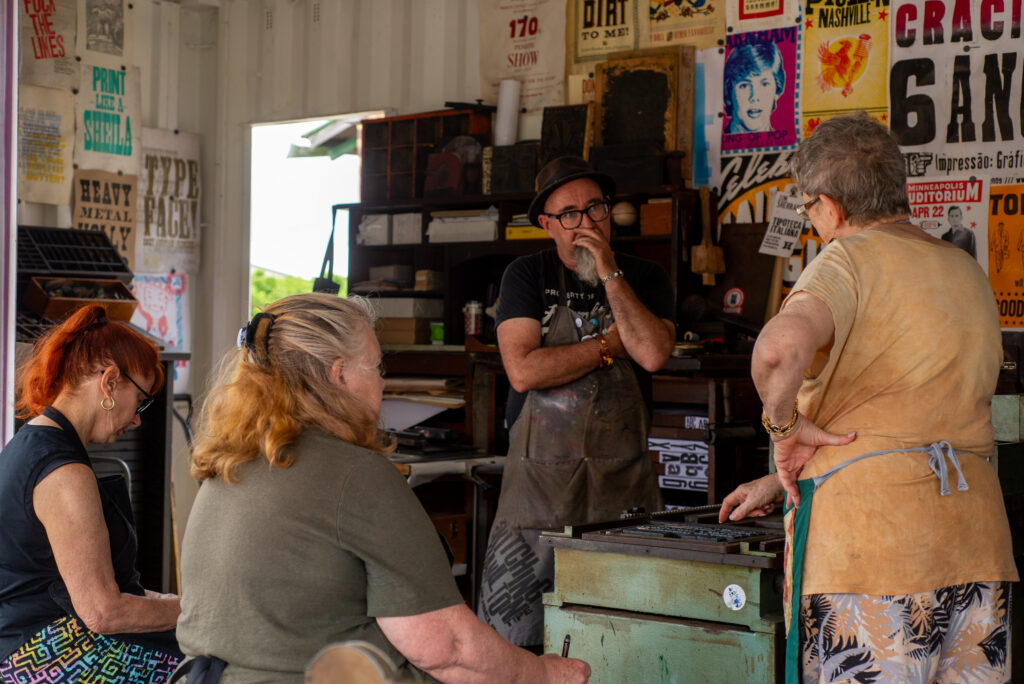
The Moveable Type Studio residency at The Paint Factory has enabled us to engage closely with some of Australia’s most established artists. In recent years, both local and international visual artists have organically formed a community, making The Paint Factory their creative home.
The artwork created on-site has been exhibited and sold nationally and internationally, with pieces featured in prestigious collections such as the Tate Modern (UK), the Art Institute of Chicago (US), the National Gallery of Canada, and the National Gallery of Australia. The unique atmosphere of The Paint Factory inspires artists to gather, discuss, and create, while also serving as a venue for educational initiatives that attract guests from around the globe. Additionally, it has become a sought-after filming location for projects like Netflix shows and music videos, and has hosted high-profile events, including Brisbane Fashion Week and the Brisbane Festival.
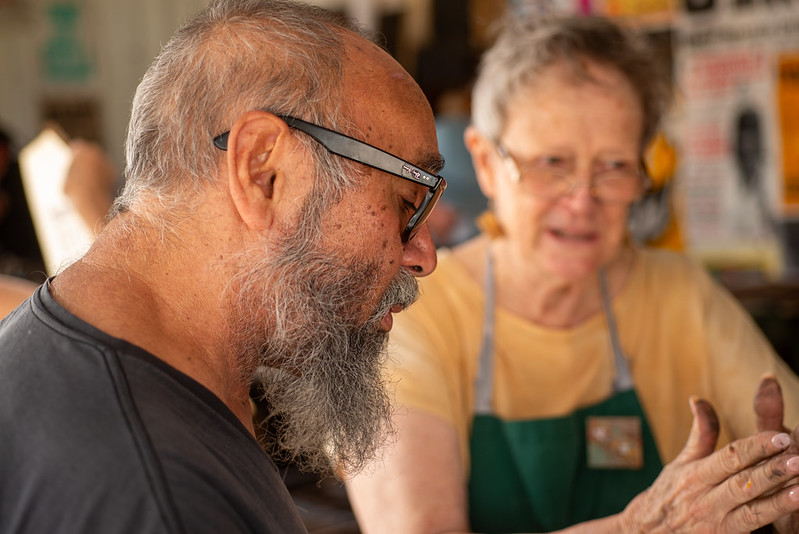
Within this vibrant space, renowned resident artists such as Gordon Hookey, Judy Watson, Richard Bell, Megan Cope, and the unforgettable Pope Alice (Luke Roberts) thrive. Our workshop not only allowed participants to learn the craft of letterpress but also to engage directly with some of Australia’s most esteemed artists.
Our letterpress workshop began with the perfect blend of coffee and conversation as a diverse group of creatives gathered around the composing table. I felt like a student myself as participants shared their fascinating stories. Among the group were senior academic directors, master paper and fibre specialists, and skilled basket makers, and incredible stories were shared, including that of a parish priest whose printing collection was housed in his clergy rooms. This eclectic mix, united by a passion for print and a curiosity for the printed word created an enriching atmosphere.
We kicked off the workshop by introducing the fundamental concept of “type high,” a crucial measurement in letterpress printing. Participants quickly immersed themselves in the tools of the trade—reglets, quoins, chases, and pica rules. Laughter and lively banter filled the room as everyone explored the Moveable Type Studio’s collection of authentic artifacts. Our discussion about type high prompted a deeper dive into international printing standards, including the 0.918-inch English and American standards and the variations in French and Italian gauges. This technical insight became essential as we prepared our compositions for printing, emphasising the multicultural history embedded within each type block—a meaningful foundation for our letterpress journey.
Next, participants embarked on the hands-on portion of the workshop by selecting a small collection of type sorts from the Moveable Type Studio collection. Armed with a type high gauge, we measured each sort, compared heights, and discussed the intricacies of printing types. This collaborative discussion guided us in selecting our final group of types as we moved on to locking up our first chase.
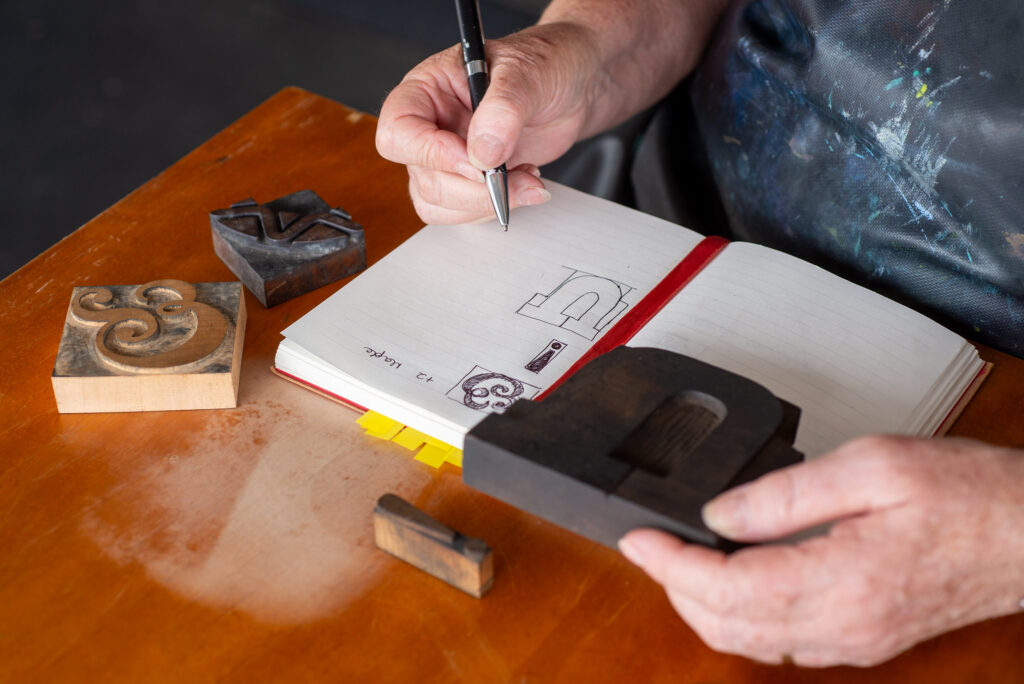
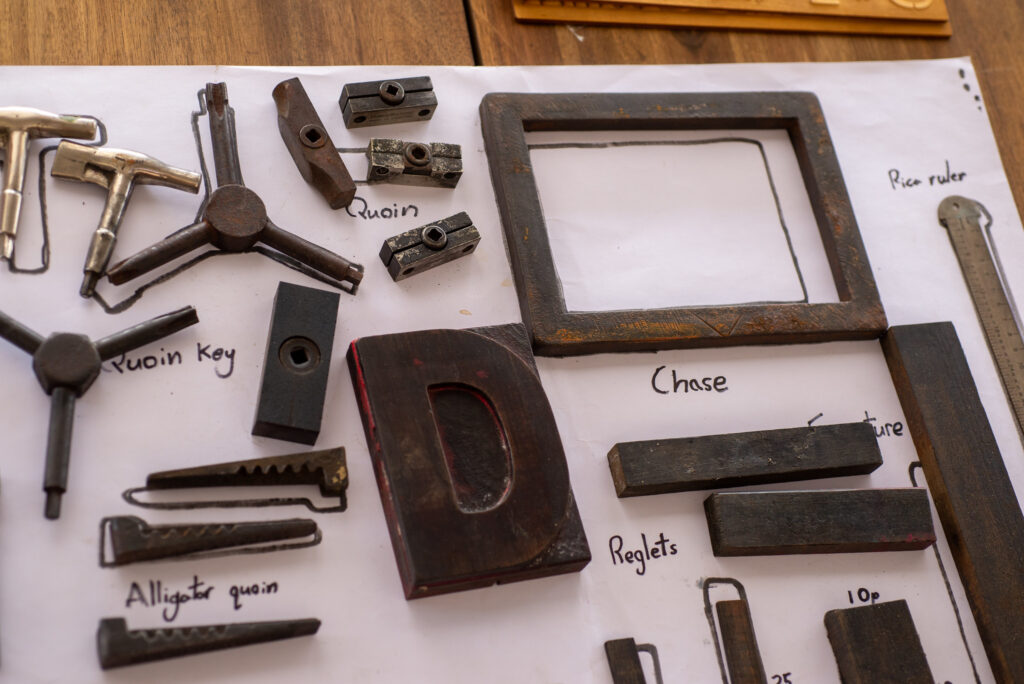
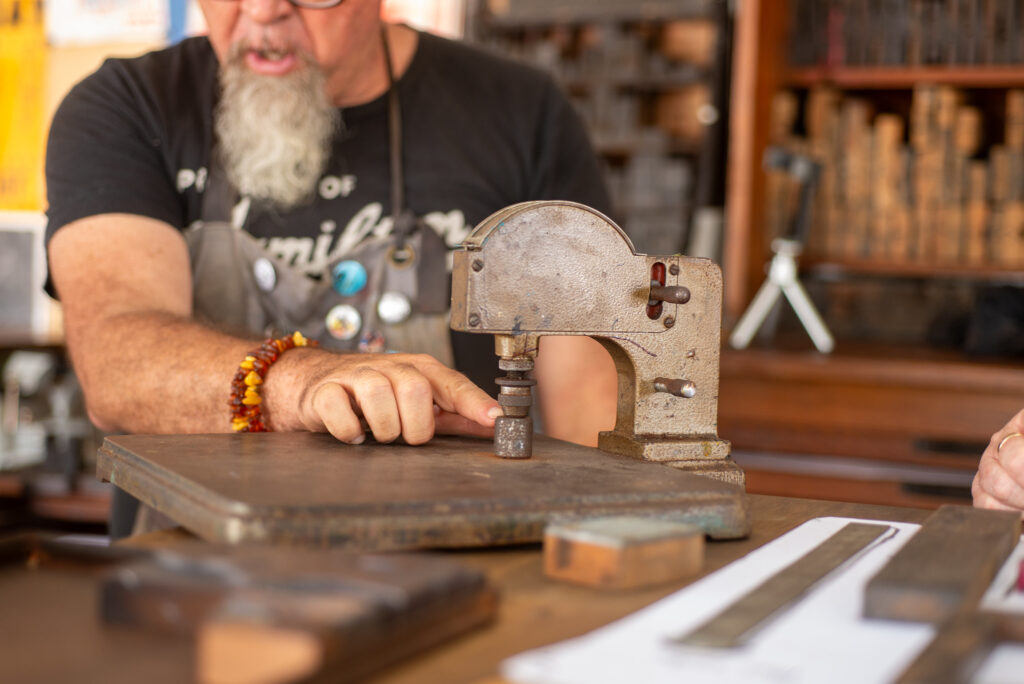
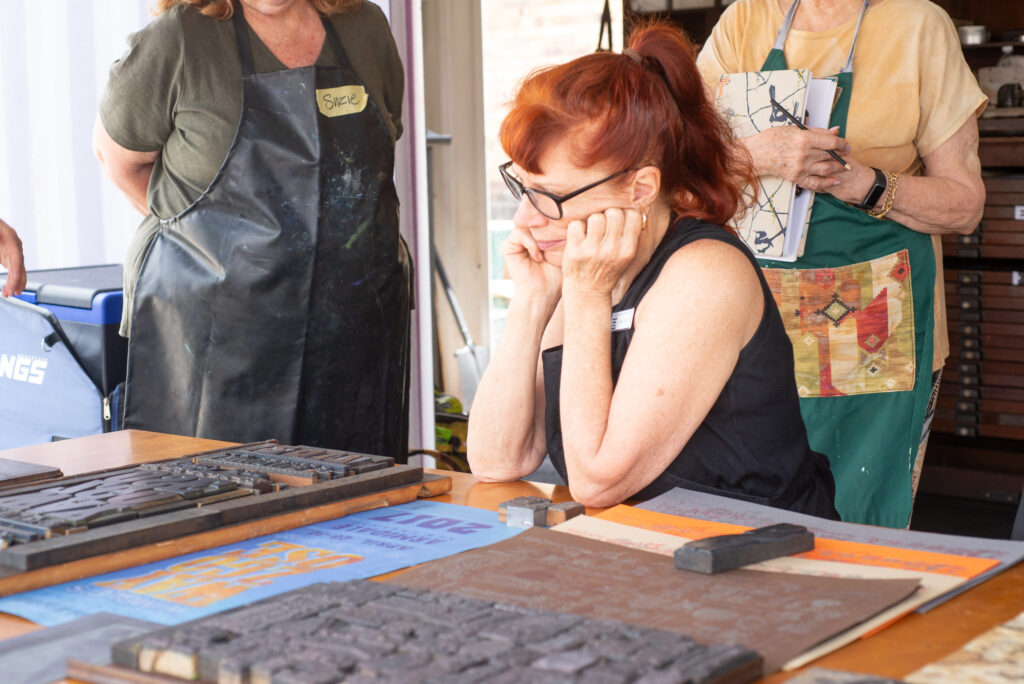
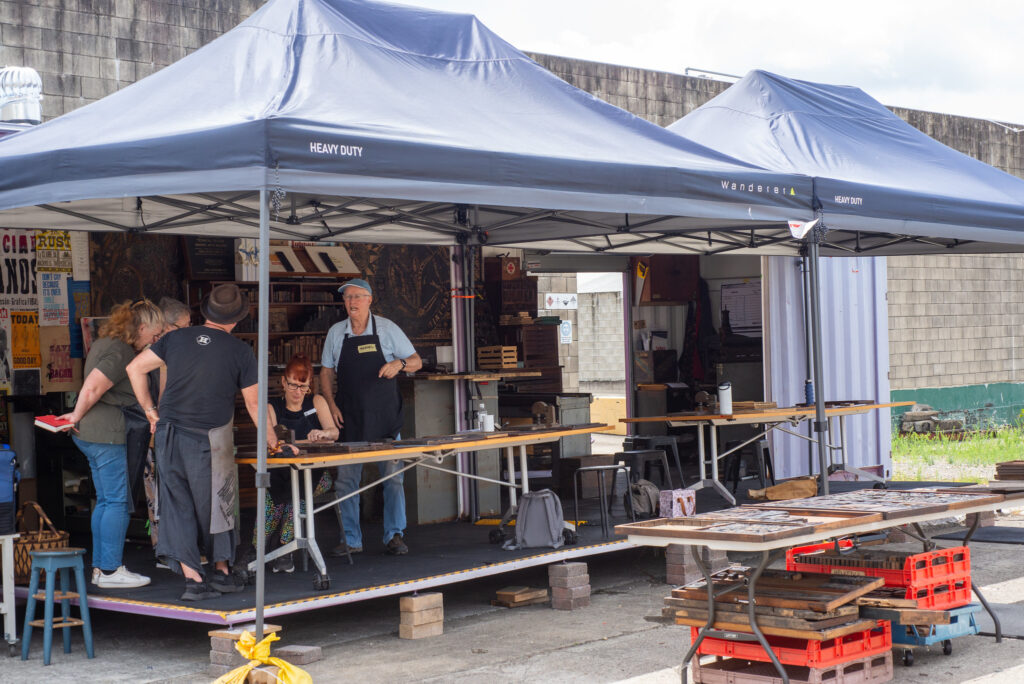
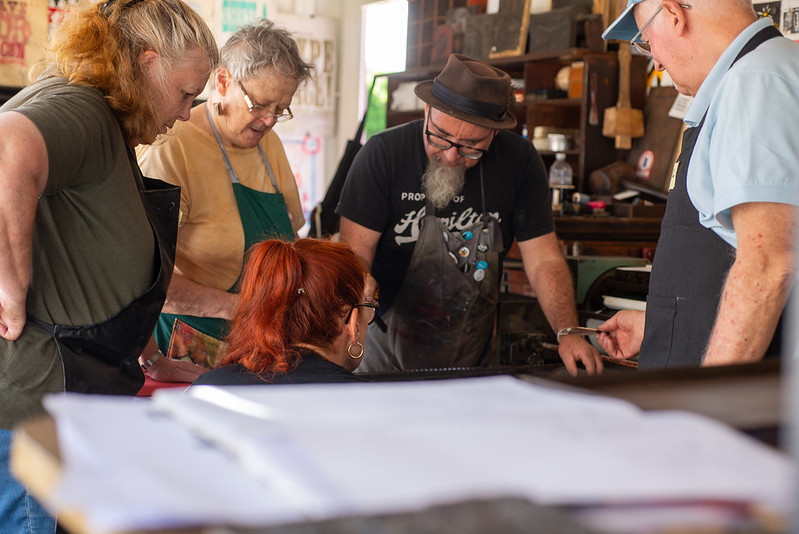
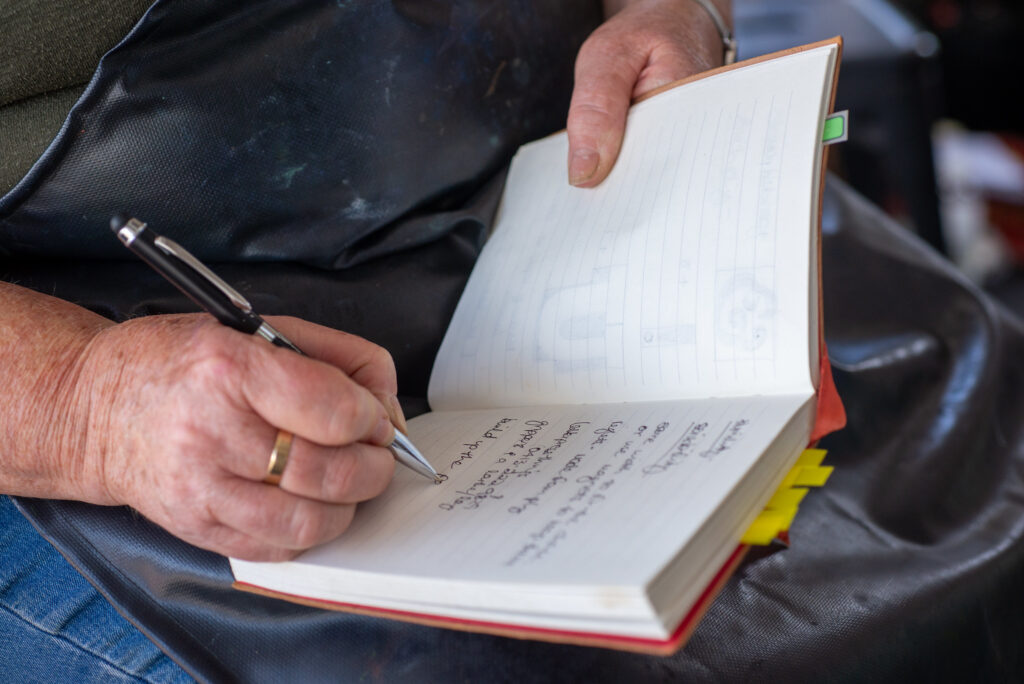
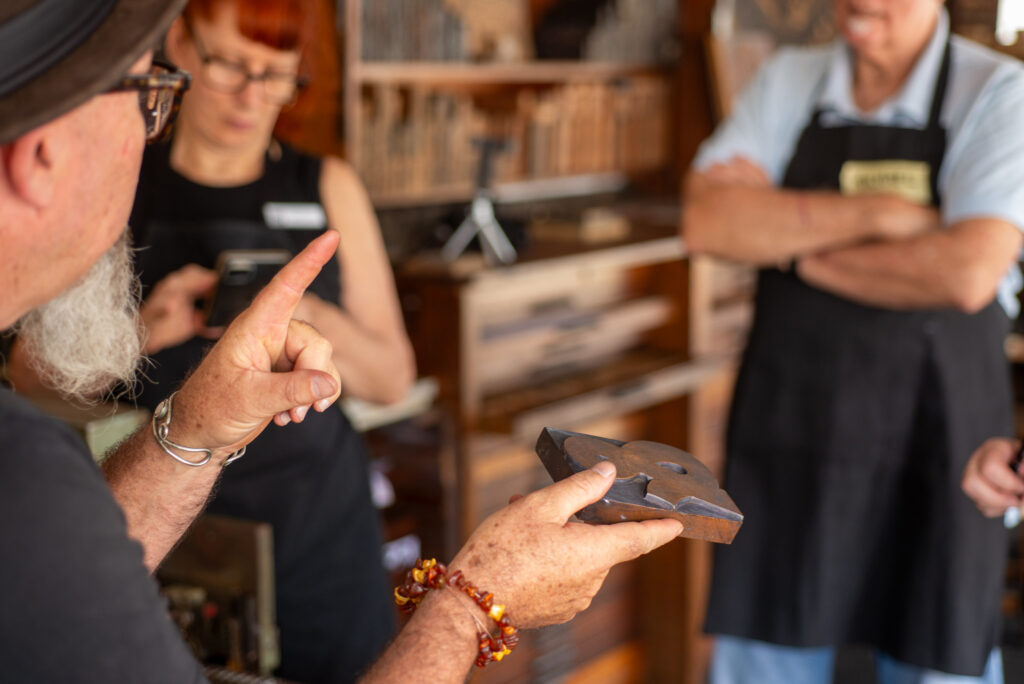
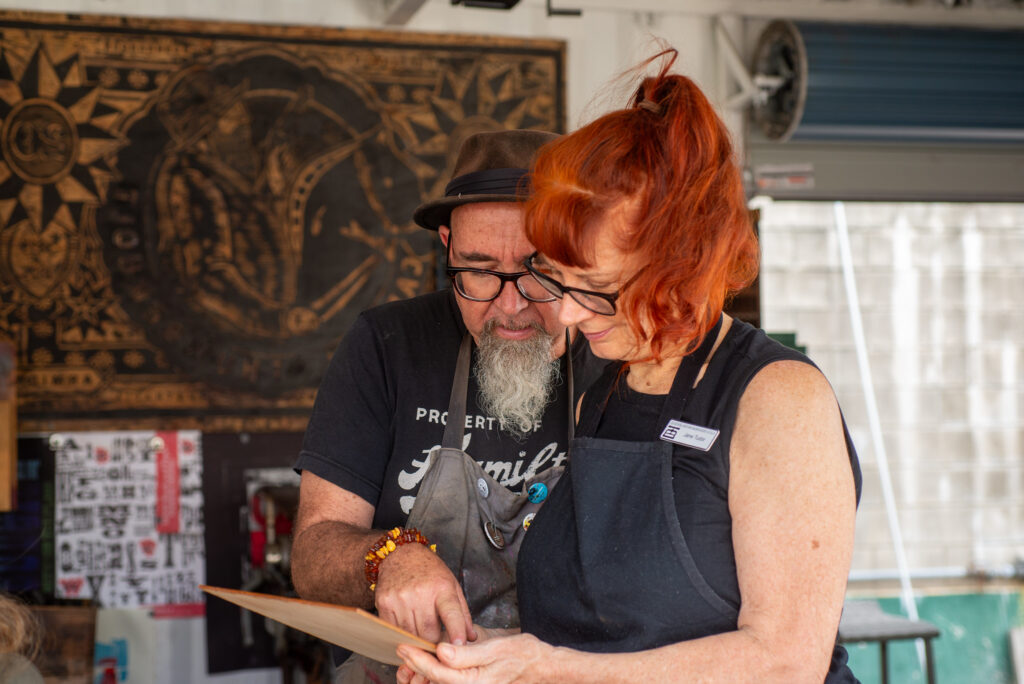
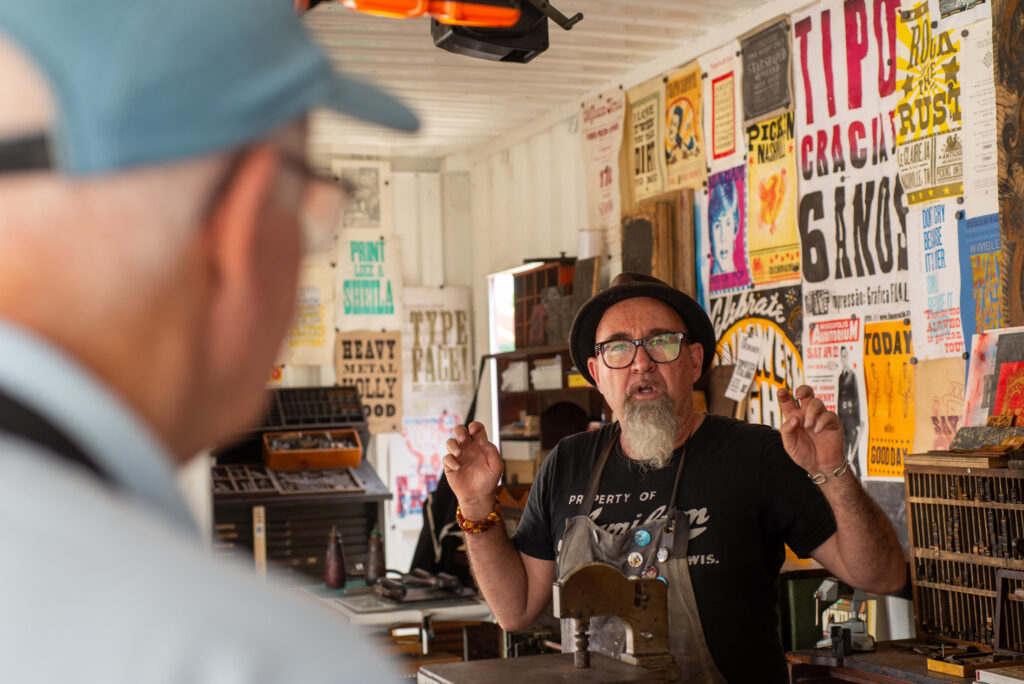
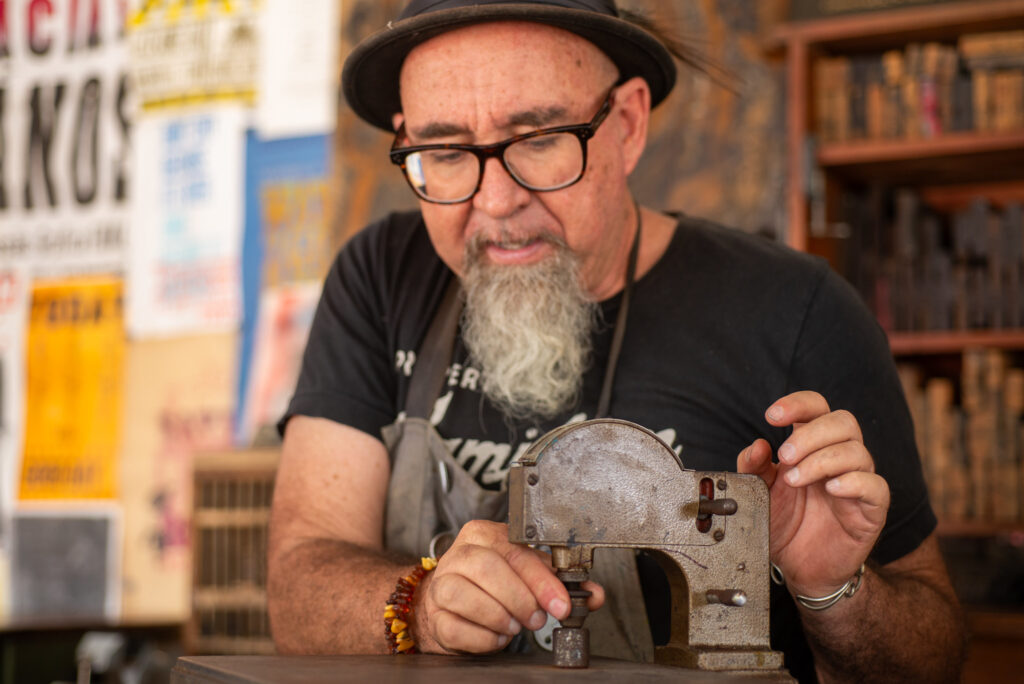
With reglets, furniture, and quoins at the ready, we collectively learned the essentials of lock-up—a crucial step for ensuring that the type stays firmly in place. Since we had a larger collaborative project in mind, I introduced an alternative setup using magnets on the bed of our FAG 405 proof press. This innovation allowed us to pull a preliminary proof and examine the impact of varying type heights firsthand. As participants inked up their types and tested the press, their confidence grew, and soon everyone was pulling proofs, excited for what lay ahead.
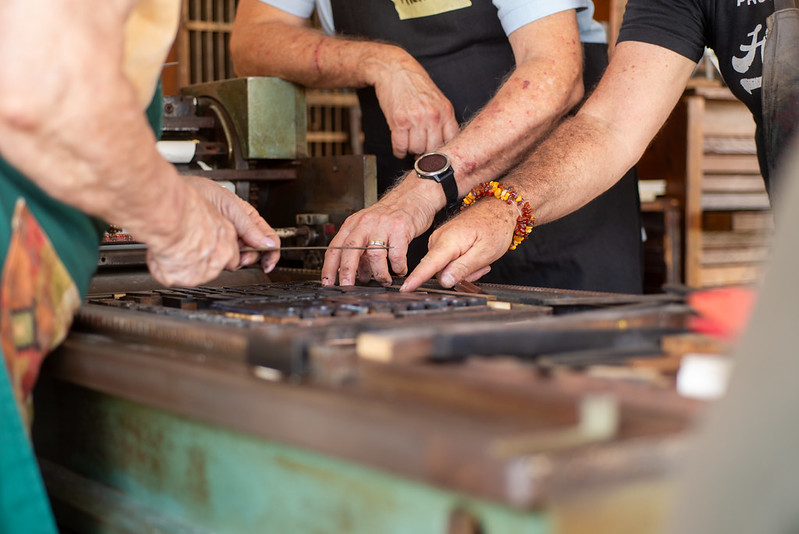
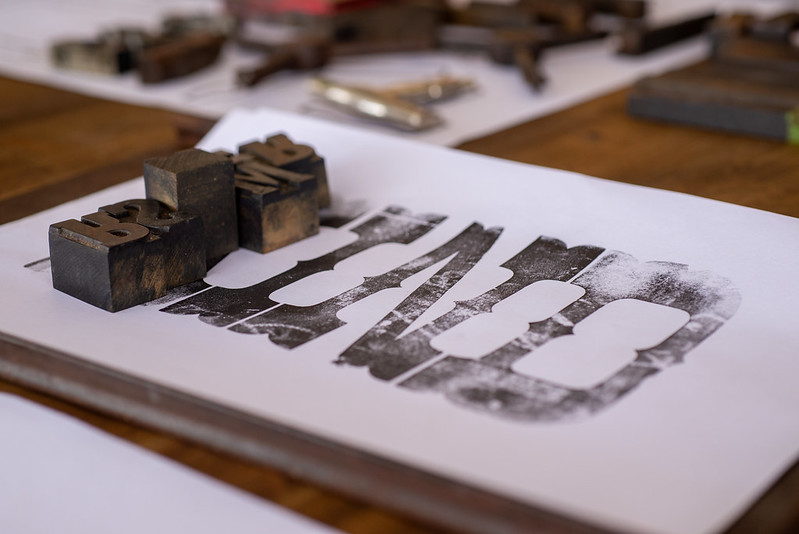
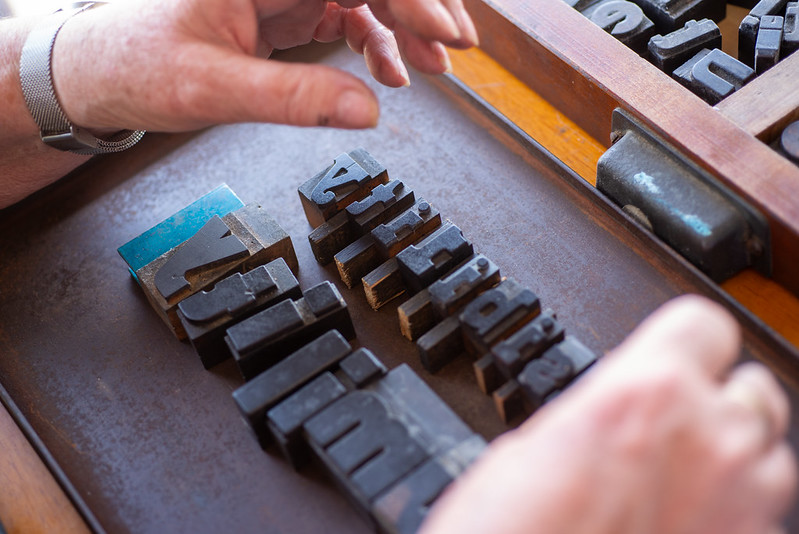
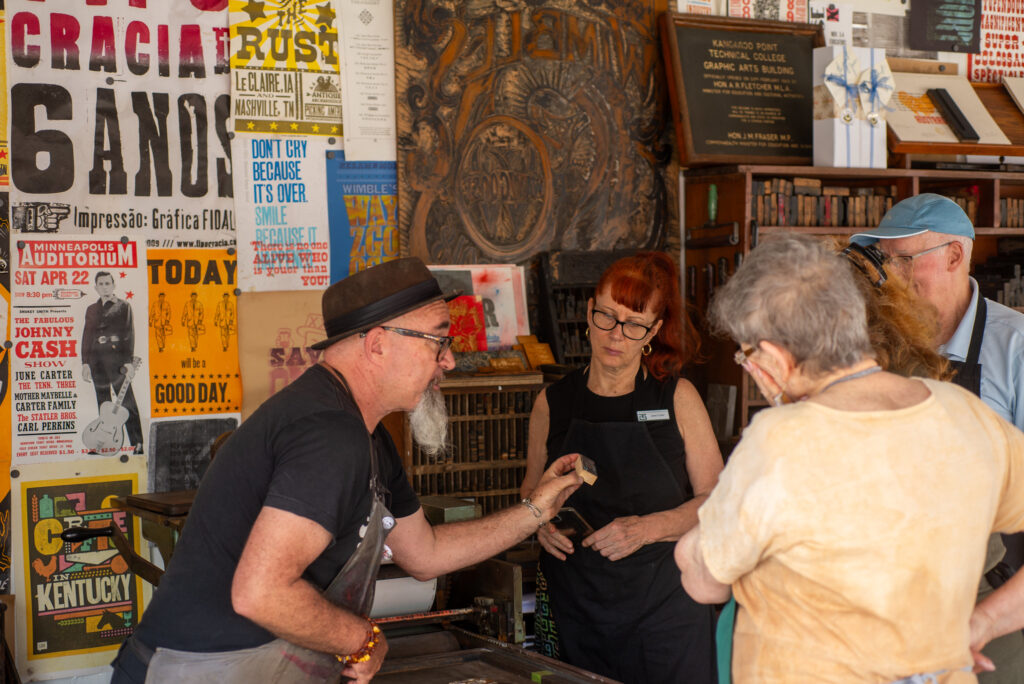
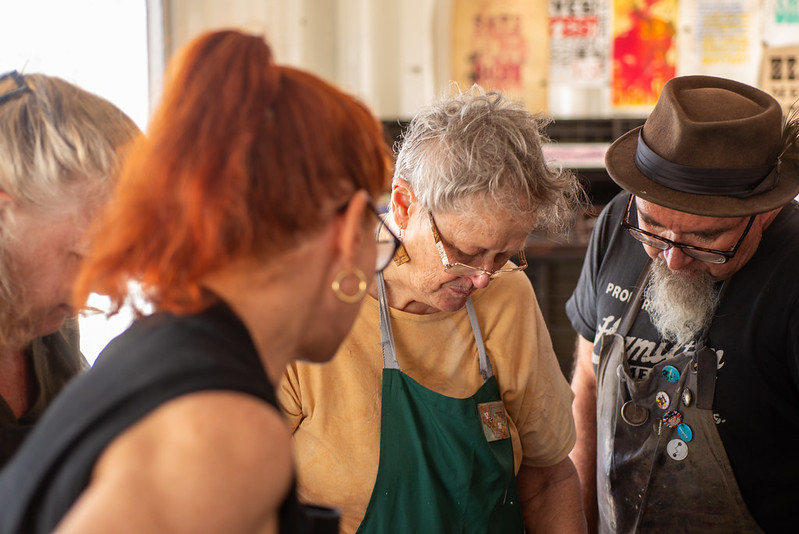
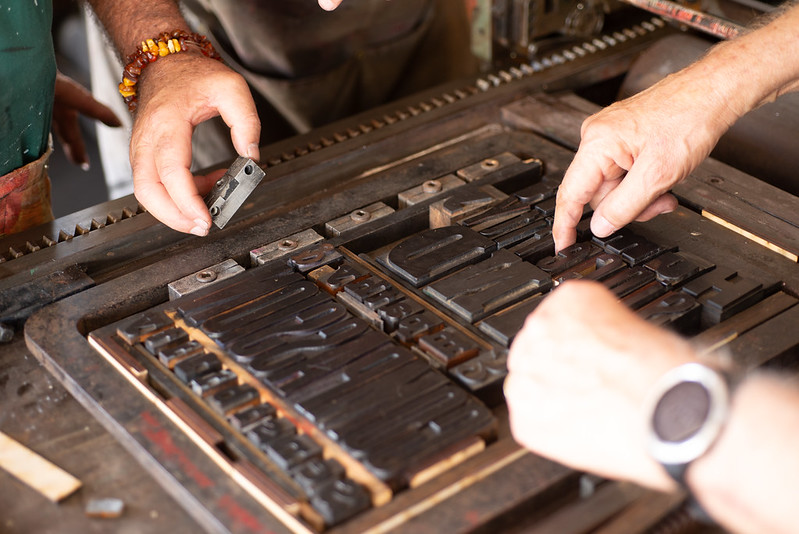
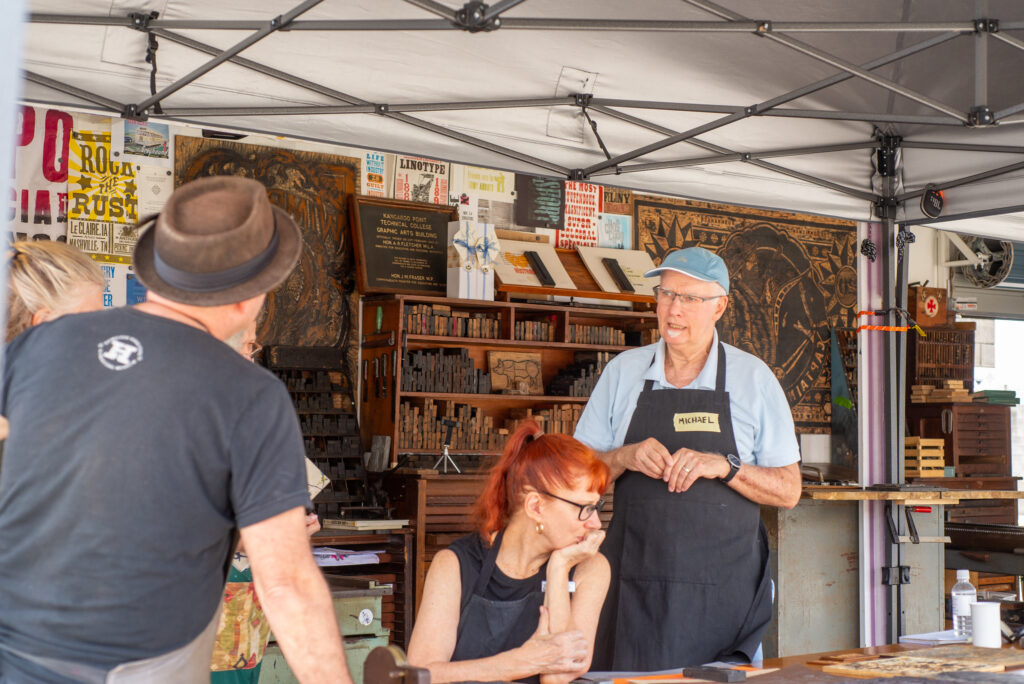
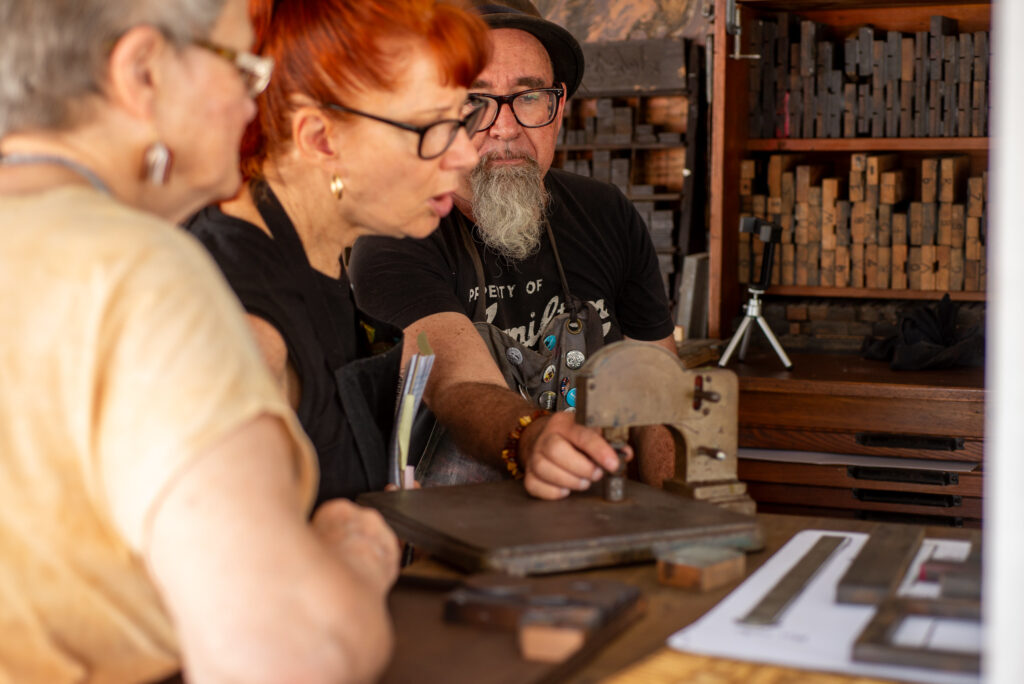

As the morning session progressed, ink was shared, and stories exchanged. We paused for a brief break, enjoying some food and each other’s company. Conversations flowed from travels in Iran to the art of painting with paper pulp. In a delightful surprise, I discovered that one of the participants was the academic director at the university where I’m currently employed! The warm Brisbane summer weather provided the perfect backdrop for laughter and inspiration before we dove into the main project of the workshop.
When we reconvened, we introduced participants to the focus of the day—a collaborative project inspired by resident artist Gordon Hookey. An Aboriginal artist renowned for his work in painting, photography, and sculpture, Gordon weaves a strong First Nations narrative into his art. Earlier in the week, he welcomed the Movable Type Studio team into his studio, a space filled with inspiration—paintings covering the walls and ceiling, vibrant with his unique commentary on culture and identity. Gordon shared a lettering piece he started during his residency at the Museum of Brisbane, where he collected words and reflections from visitors exploring a poster exhibition drawn from his personal collection.
Seeing Gordon’s work and his commitment to using lettering as a storytelling medium sparked an exciting idea. He expressed his intention for these powerful words and phrases to be shared, inviting other artists to incorporate them into their creations. From this vision, a collaboration in letters was born. Just days after our studio visit, Gordon shared his lettering files with us, and we began crafting a plan to integrate his work into our letterpress project.
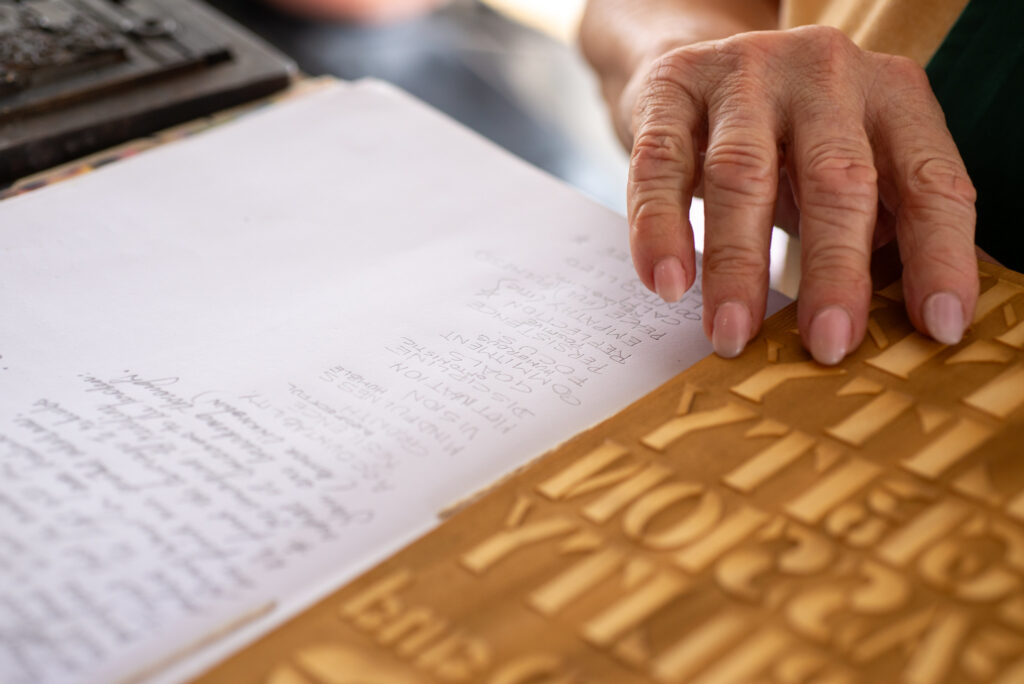
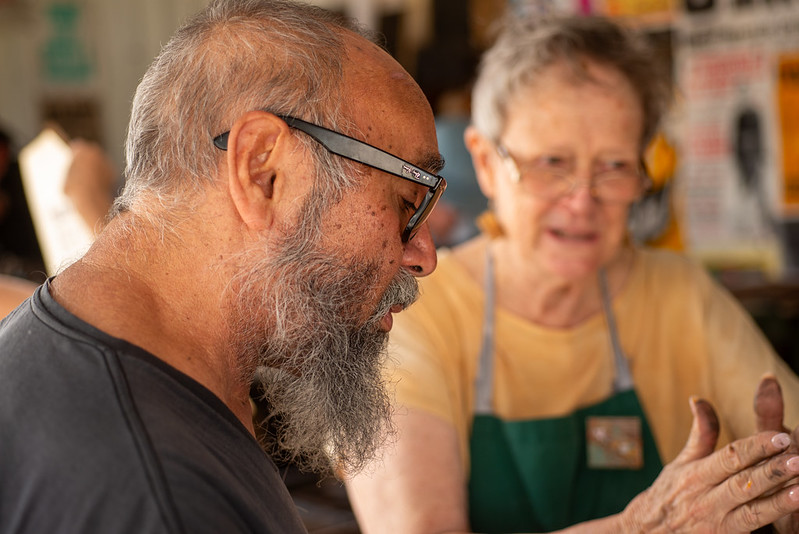
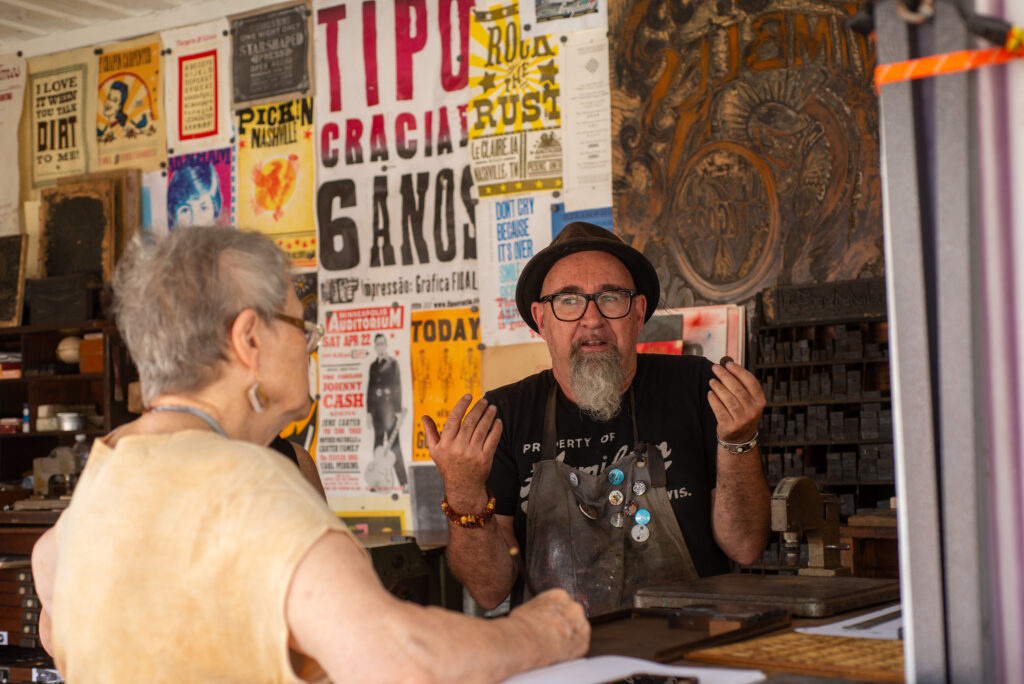
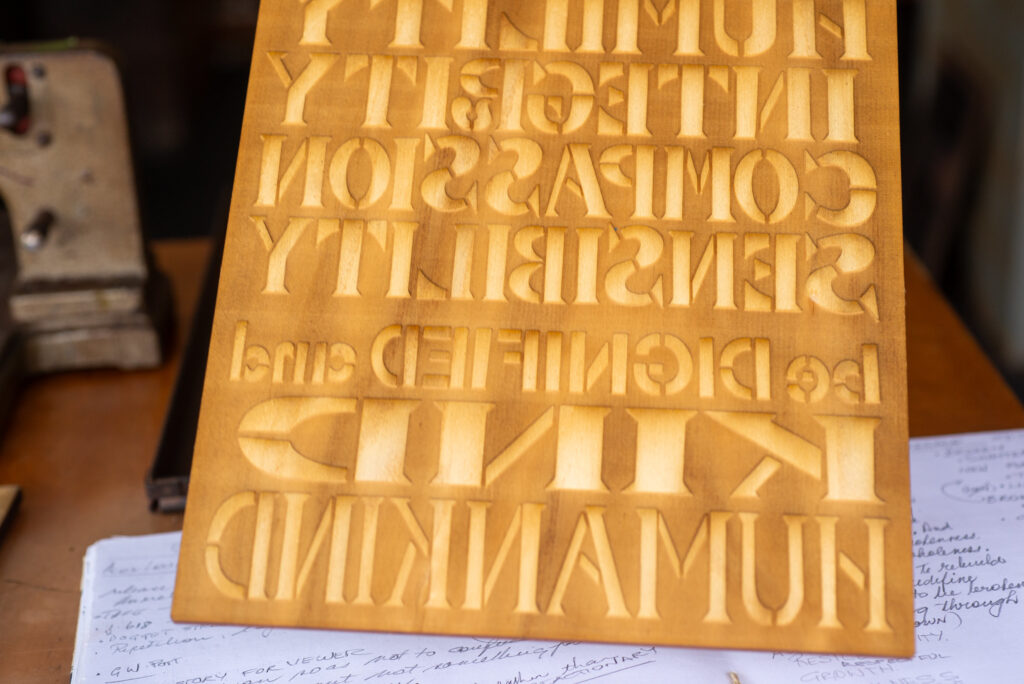
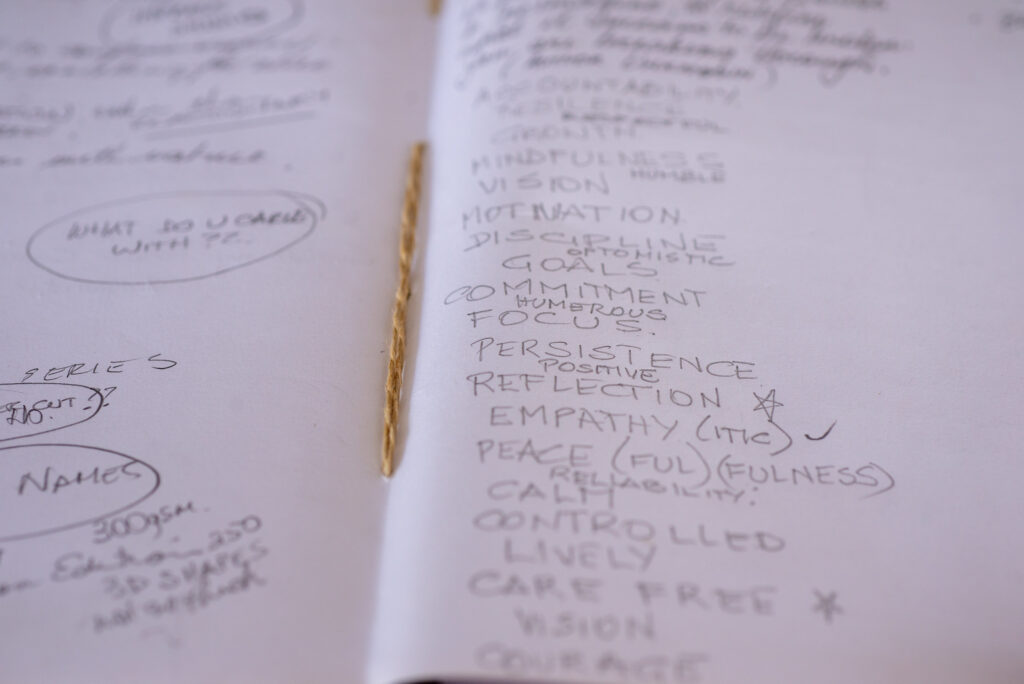
Over the past 10 months, we had been working closely with The Edge, the makers space at the State Library of Queensland, where we experimented with creating relief printing plates using their laser engraver. This collaboration with Gordon presented the perfect opportunity to merge analogue lettering with modern laser-cut plates, aligning with his vision of sharing these impactful words. Energised by Gordon’s powerful voice and the potential of our collaboration, we prepared to incorporate his words into the next stages of our letterpress journey.
Our workshop project centred around bringing Gordon’s words to life. Each participant selected a single word from his design, setting it by hand in type, all with the shared vision of merging these words into a cohesive final composition. This process required not only technical skill but also patience and collaboration. Participants quickly recognised the challenge of uniting type from various origins—French, Italian, English, and American blocks—into one harmonious layout. There was no shortcut to sizing up fonts, adjusting kerning, or fine-tuning the tracking for each word. The group often found themselves rethinking their choices to create the strongest possible collaborative piece.
This exercise evolved into a masterclass in teamwork, communication, and diplomacy. Over the next hour and a half, participants reflected on their earlier work with type, using their knowledge to prepare each word for proofing. Our goal was to create a “collage of sorts,” where each proofed word would serve as the foundation for our collaborative lockup. Amid spirited debates, occasional arm-wrestles over creative choices, and shared laughter, we made our final selections and began the intricate process of locking up our combined type composition, setting everything in place for the ultimate test—printing this collective masterpiece.
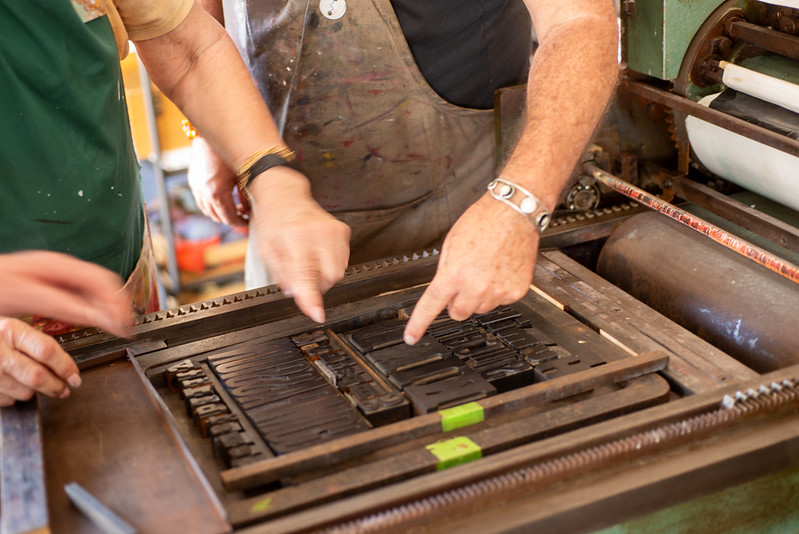
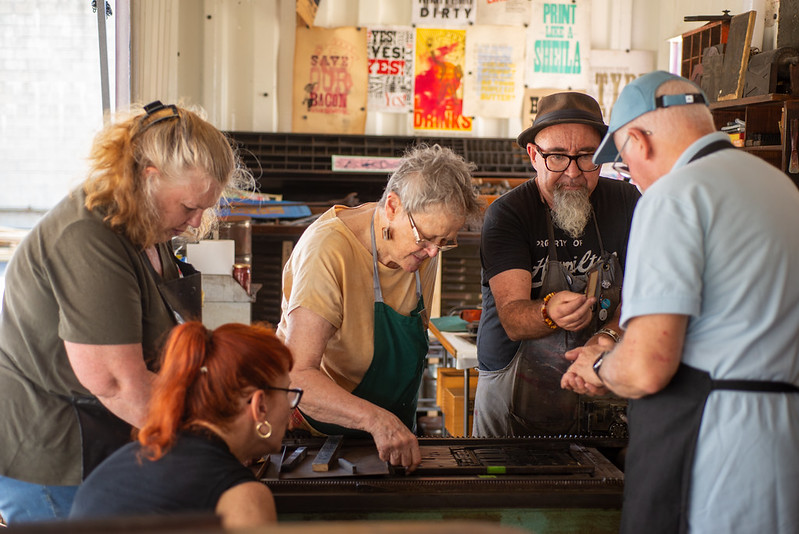

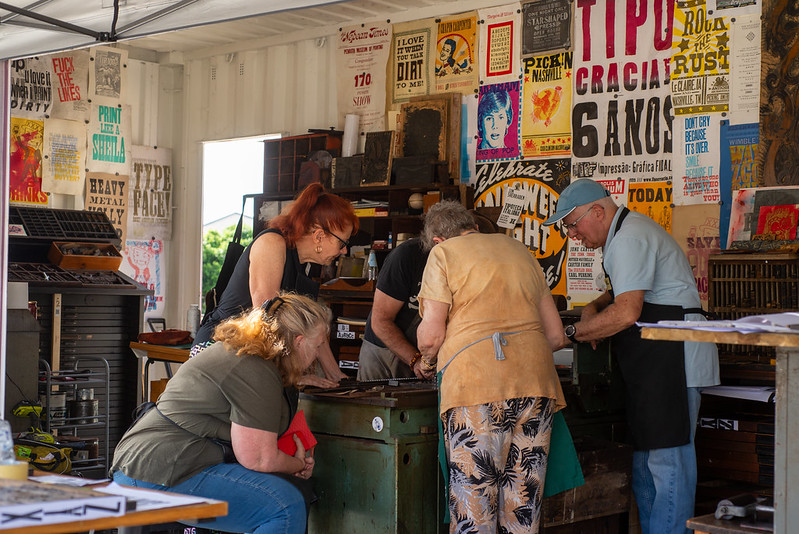
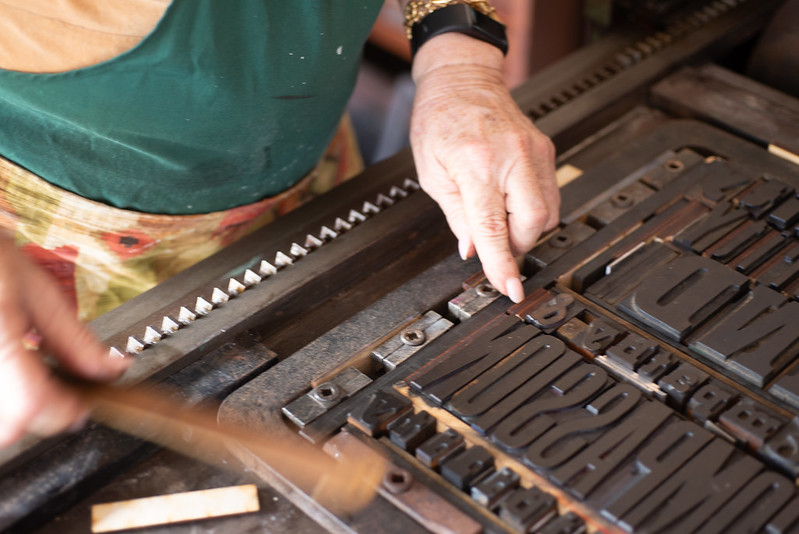
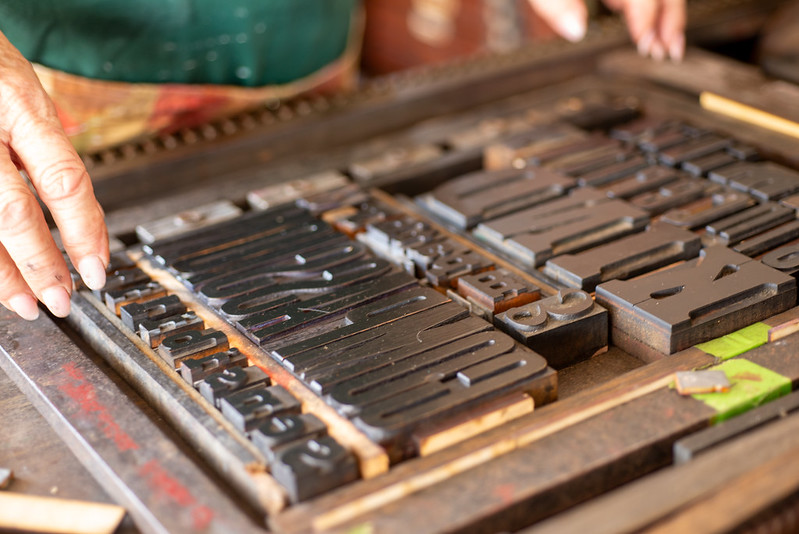

With our collaborative lockup secured, we turned to selecting paper, only to discover that our initial choice lacked the right surface quality for our intended outcome. Fortunately, with papermakers and fibre artists in attendance, a lively discussion ensued, leading us to unearth a fifty-year-old stash of newsprint. This yellowed, moisture-depleted paper had everyone on the edge of their seats as we set up for our initial proofs. The group soon agreed that simple black ink on the creamy, vintage stock struck the perfect balance.
Then, Clint couldn’t resist sharing an inking technique from English typography master Alan Kitching, known for his expressive ink application directly onto wood type. With a palette of reds, yellows, and blacks, participants created prints that pulsed with the vibrancy of each chosen word, bringing Gordon’s powerful language to life with bold energy.
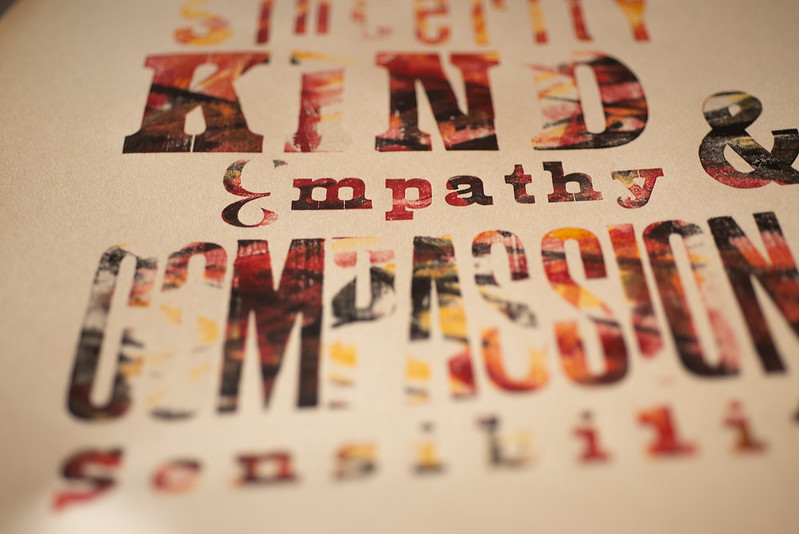
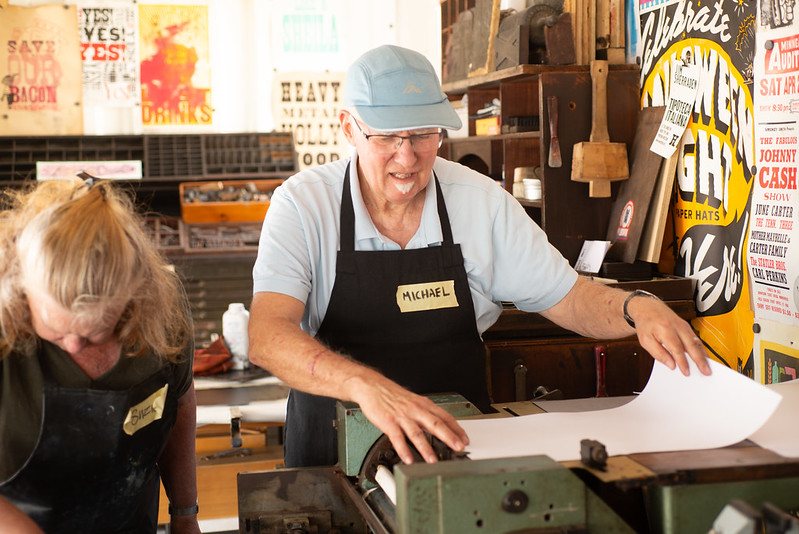
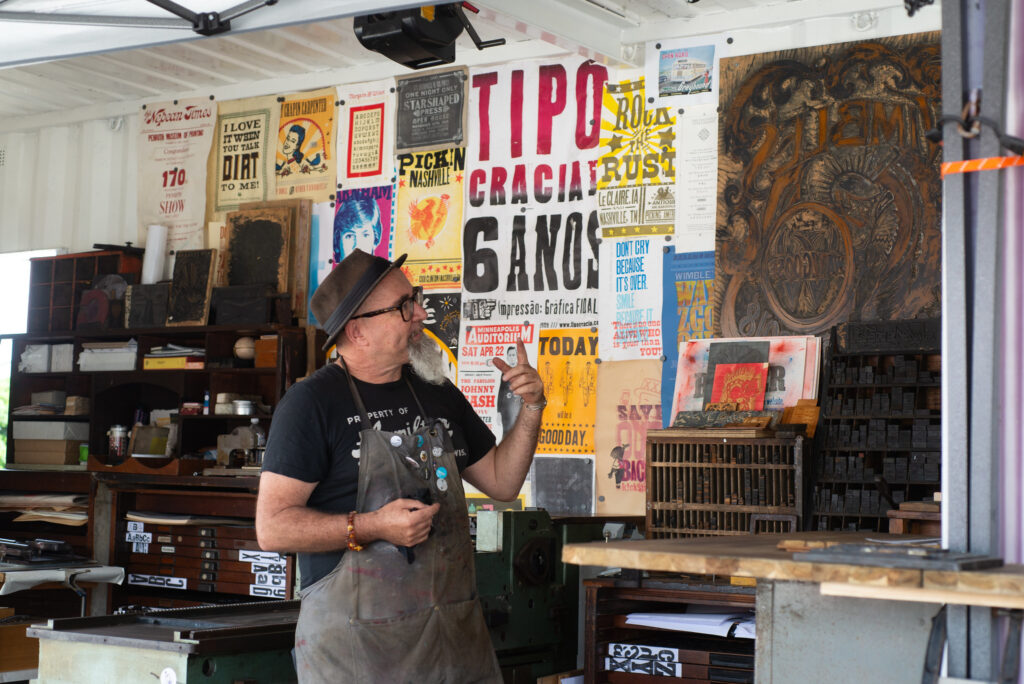

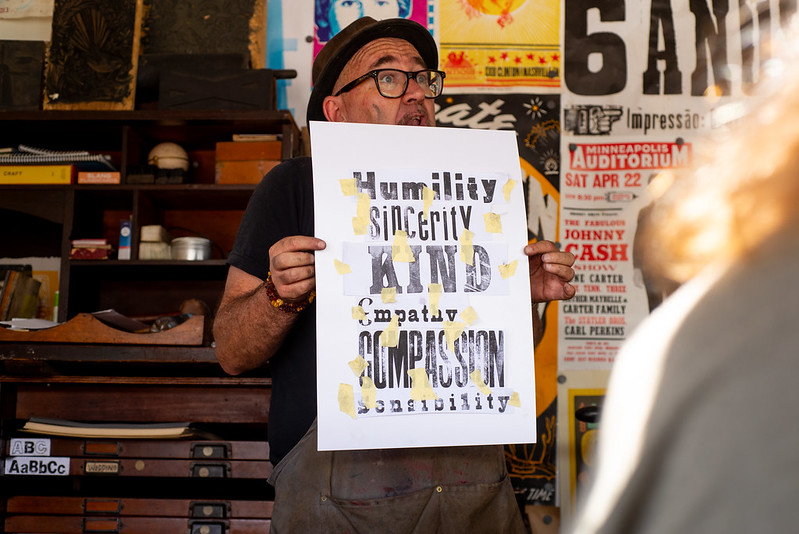
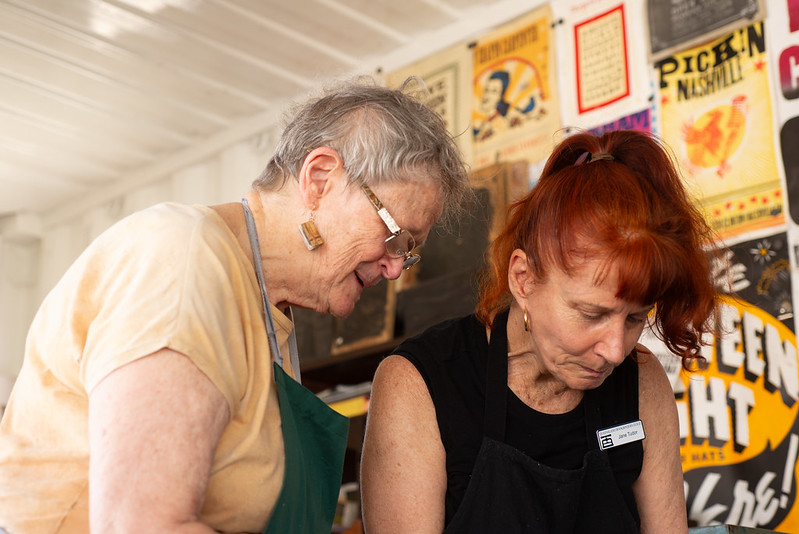
As the workshop drew to a close, we reflected on the day’s lessons, the rich conversations, and the friendships formed around the composing table. For many, this introduction to letterpress opened the door to future projects, as several participants eagerly planned to book one-on-one press time in our open studio. The Movable Type Studio offers open studio hire for those who have completed a workshop and passed our safety induction, making it the perfect next step for our budding letterpress enthusiasts. With plans laid and ink-stained fingers as souvenirs, we wrapped up, looking forward to seeing these new typographers return to bring their own creations to life.
At The Paint Factory, a vibrant creative community thrives, where collaboration, culture, and craftsmanship converge. Our workshop with Gordon Hookey—a celebrated Aboriginal artist whose work infuses First Nations voices into bold, contemporary forms—brought together a diverse group of makers and storytellers, each contributing to a shared narrative.

Here, traditional and modern print practices meet in a process that honours kinesthetic learning: a hands-on experience where participants slow down, engage deeply and feel the textures of ink and paper in real-time. In a world increasingly reliant on digital networks, this analog approach reminds us of the value of presence, of learning through doing, and of connecting with others face-to-face. It’s a space for reflection, creativity, and collaboration, fostering not only artistic skills but also meaningful connections among people dedicated to the art of making.
